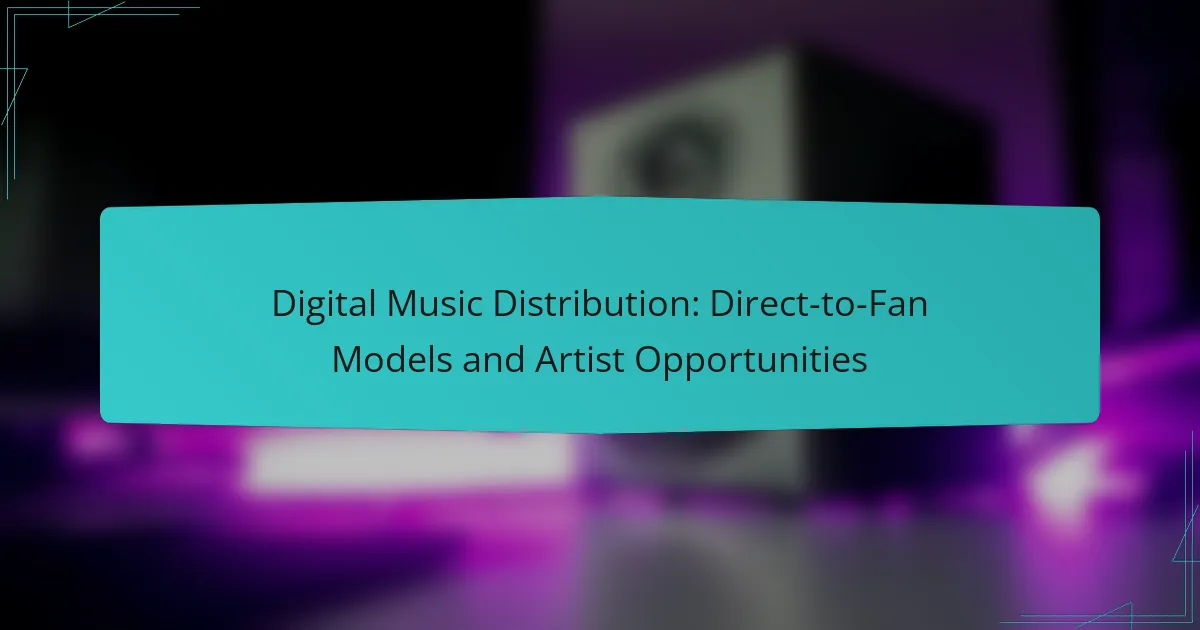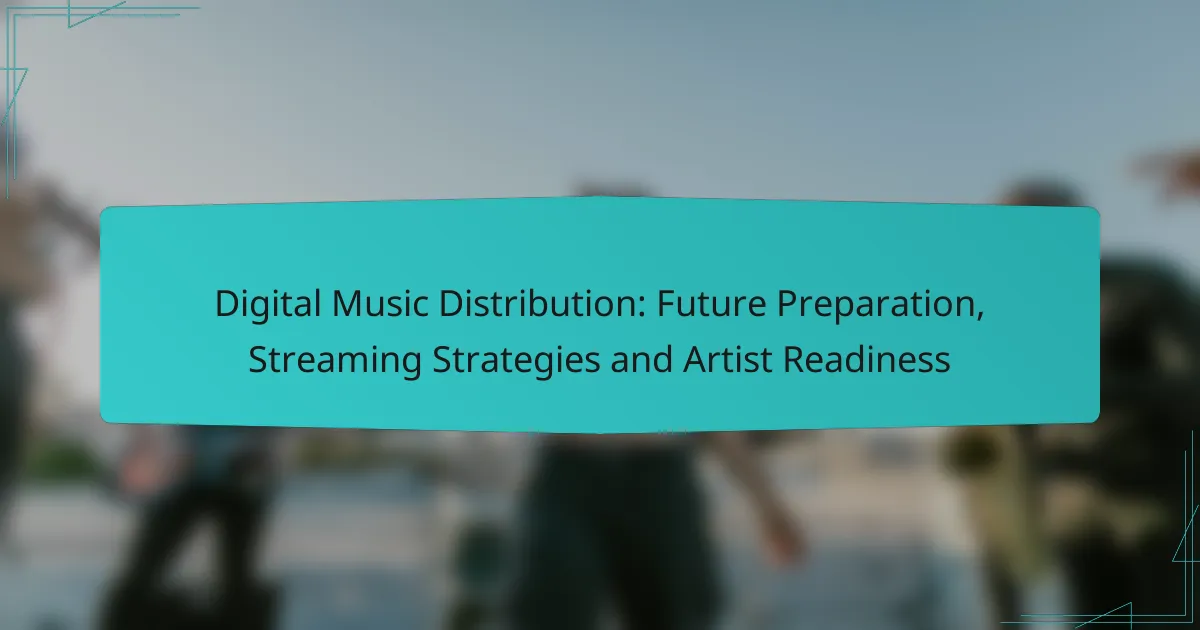Digital music distribution has evolved to empower artists through direct-to-fan models, allowing them to engage with their audience while maintaining greater control over their music and revenue. By utilizing these platforms, musicians can sell their music, merchandise, and exclusive content directly to fans, effectively bypassing traditional distribution channels and maximizing their earnings.

What are the best direct-to-fan digital music distribution platforms?
The best direct-to-fan digital music distribution platforms enable artists to connect with their audience while retaining more control over their music and revenue. These platforms provide tools for selling music, merchandise, and exclusive content directly to fans, often bypassing traditional distribution channels.
Bandcamp
Bandcamp is a popular platform for independent artists to sell their music and merchandise directly to fans. Artists can set their own prices, offer digital downloads, and even sell physical items like vinyl and CDs. Bandcamp takes a percentage of sales, typically around 15% for digital and 10% for physical goods, allowing artists to keep most of their earnings.
One of the key features of Bandcamp is its “name your price” option, which encourages fans to pay what they feel is fair. This can lead to higher earnings, especially if fans are passionate about the artist’s work. Additionally, Bandcamp provides tools for artists to engage with their audience through mailing lists and exclusive releases.
Patreon
Patreon is a membership platform that allows artists to earn a recurring income from their most dedicated fans. Creators can offer various subscription tiers, each providing different levels of access to exclusive content, such as unreleased tracks, behind-the-scenes videos, or personalized merchandise. This model fosters a deeper connection between artists and their supporters.
To succeed on Patreon, artists should focus on delivering consistent value to their subscribers. Regular updates and engaging content are crucial for retaining members. Artists should also consider setting realistic goals for their subscriber count and pricing tiers to ensure sustainability.
SoundCloud Pro
SoundCloud Pro offers artists enhanced features for distributing and monetizing their music on the platform. With a Pro account, artists can upload unlimited tracks, access detailed analytics, and utilize promotional tools to reach a wider audience. This is particularly beneficial for emerging artists looking to build a fanbase.
SoundCloud also allows for monetization through its Premier program, where eligible artists can earn revenue from their streams. Artists should be aware that building a following on SoundCloud requires active engagement with listeners and consistent content uploads to maximize visibility.
Spotify for Artists
Spotify for Artists provides musicians with tools to manage their profiles, track performance metrics, and promote their music effectively. Artists can claim their profiles, customize their bios, and share playlists to engage listeners. This platform is essential for artists aiming to reach a global audience.
Using Spotify for Artists effectively involves regularly updating content and utilizing promotional features like Spotify Canvas and Marquee ads. Artists should also focus on getting added to playlists, as this can significantly increase their streams and visibility on the platform.
Apple Music for Artists
Apple Music for Artists offers similar tools to Spotify, allowing musicians to analyze their streaming data and manage their presence on the platform. Artists can view detailed insights about their listeners, including demographics and listening habits, which can inform marketing strategies.
To leverage Apple Music effectively, artists should ensure their music is well-promoted across social media and other channels. Engaging with fans and encouraging them to add songs to their personal playlists can also enhance visibility and drive more streams.
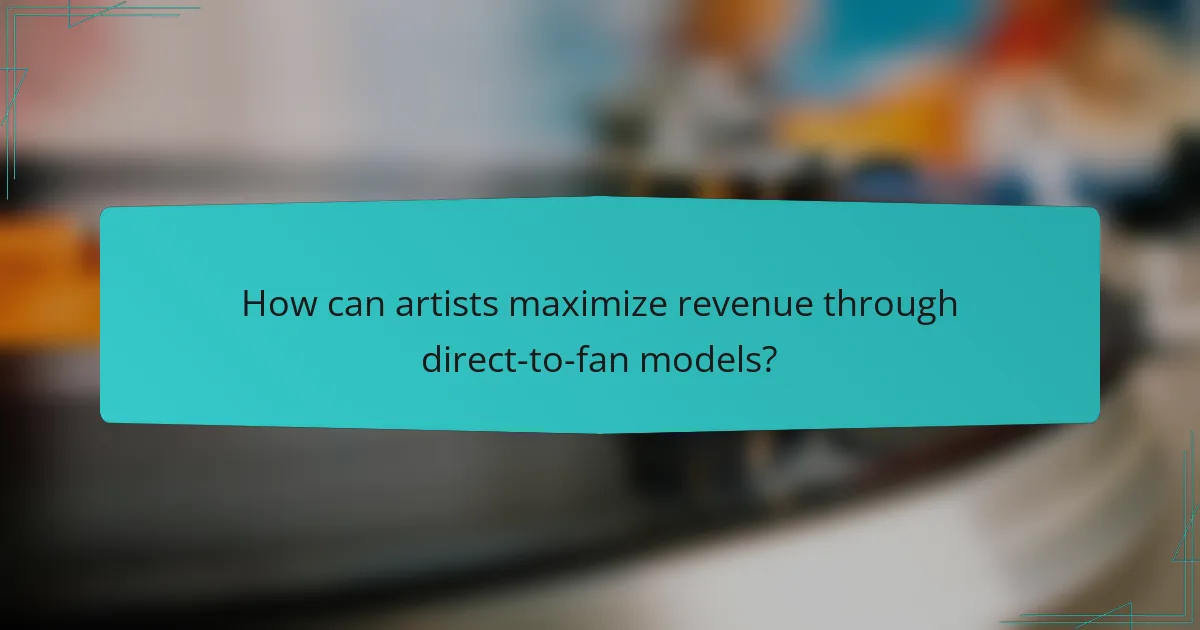
How can artists maximize revenue through direct-to-fan models?
Artists can maximize revenue through direct-to-fan models by engaging their audience directly, cutting out intermediaries, and offering unique products and experiences. This approach allows musicians to retain a larger share of their earnings while building a loyal fanbase.
Merchandise sales
Merchandise sales are a significant revenue stream for artists using direct-to-fan models. By selling items such as T-shirts, posters, and vinyl records directly to fans, artists can earn higher profit margins compared to traditional retail channels.
To effectively sell merchandise, artists should consider creating limited edition items or bundles that include exclusive content. This strategy not only boosts sales but also enhances fan engagement. Platforms like Bandcamp or Shopify can facilitate these sales, allowing artists to manage inventory and transactions easily.
Exclusive content offerings
Offering exclusive content is a powerful way for artists to generate additional income. This can include behind-the-scenes videos, early access to new music, or special live-streamed performances. Fans are often willing to pay a premium for content that enhances their connection to the artist.
Artists can use subscription models or one-time purchases to deliver this exclusive content. For instance, platforms like Patreon allow fans to subscribe for monthly fees, providing artists with a steady income while offering fans unique experiences and materials.
Crowdfunding campaigns
Crowdfunding campaigns can help artists finance new projects while fostering a sense of community among fans. By using platforms like Kickstarter or Indiegogo, artists can raise funds for albums, tours, or special projects by offering rewards to backers.
Successful crowdfunding requires clear goals and engaging rewards. Artists should communicate their vision effectively and consider offering tiered rewards, such as signed merchandise or personal experiences, to encourage higher contributions. Setting a realistic funding goal and timeline is crucial to maintaining momentum throughout the campaign.
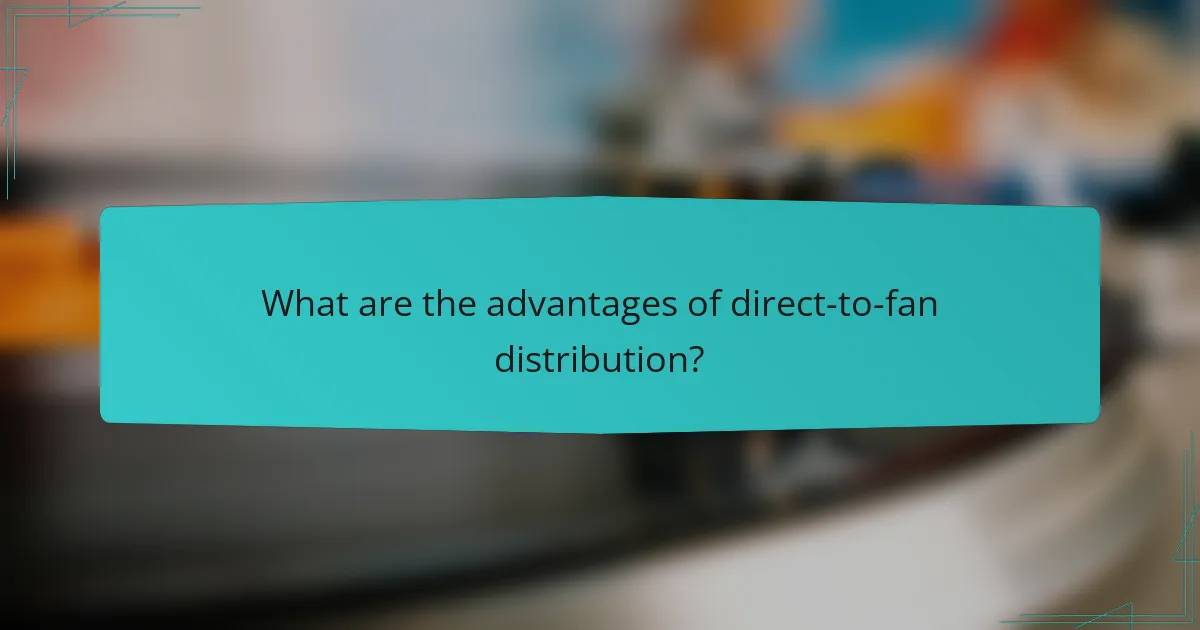
What are the advantages of direct-to-fan distribution?
Direct-to-fan distribution offers artists a way to connect with their audience while maximizing their earnings. This model eliminates intermediaries, allowing musicians to retain more control over their music and fan interactions.
Higher profit margins
By bypassing traditional distribution channels, artists can significantly increase their profit margins. Instead of sharing revenue with record labels and distributors, musicians can keep a larger portion of sales from digital downloads and merchandise.
For instance, while a typical record label might take 70% of sales, direct-to-fan platforms allow artists to retain up to 85% or more. This shift can lead to substantial financial benefits, especially for independent artists.
Stronger fan relationships
Direct-to-fan distribution fosters deeper connections between artists and their supporters. By engaging directly, musicians can build a loyal fan base that feels more invested in their work.
Through personalized communication, exclusive content, and direct sales, artists can create a sense of community. For example, offering limited edition merchandise or behind-the-scenes access can enhance fan loyalty and encourage repeat purchases.
Data ownership
Artists who utilize direct-to-fan models gain ownership of valuable data regarding their audience. This information includes insights into purchasing behaviors, demographic details, and engagement metrics.
Having access to this data allows musicians to tailor their marketing strategies and make informed decisions about future releases. For example, knowing which songs resonate most with fans can guide setlists for live performances or inform the direction of new music projects.
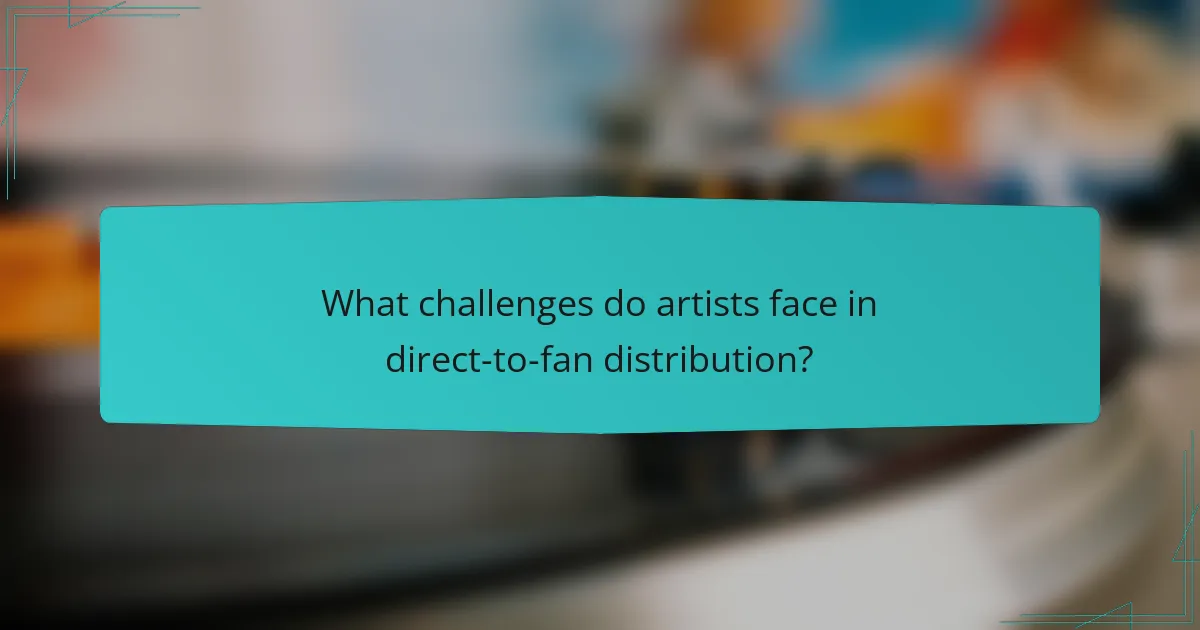
What challenges do artists face in direct-to-fan distribution?
Artists encounter several challenges in direct-to-fan distribution, including marketing and promotion, platform fees, and content piracy. These obstacles can hinder their ability to effectively reach audiences and maximize revenue from their music.
Marketing and promotion
Effective marketing and promotion are crucial for artists to succeed in direct-to-fan distribution. Without a strong promotional strategy, even the best music may go unnoticed. Artists should consider leveraging social media, email newsletters, and collaborations with influencers to build their audience.
Budget constraints often limit marketing efforts, so focusing on cost-effective strategies is essential. Engaging with fans through live streams, behind-the-scenes content, and exclusive offers can create a loyal fanbase and enhance visibility.
Platform fees
Many direct-to-fan platforms charge fees that can significantly impact an artist’s earnings. These fees may include transaction costs, subscription charges, or a percentage of sales. Artists should carefully evaluate the fee structures of different platforms to choose one that aligns with their financial goals.
For instance, some platforms may offer lower fees but fewer features, while others might charge higher fees but provide extensive marketing tools. Understanding these trade-offs is vital for maximizing revenue from direct-to-fan sales.
Content piracy
Content piracy poses a significant threat to artists in the digital music landscape. Unauthorized distribution of music can lead to lost revenue and diminished control over their work. Artists should consider using digital rights management (DRM) tools and watermarking to protect their content.
Additionally, educating fans about the value of supporting artists through legitimate channels can help combat piracy. Offering exclusive content or experiences can incentivize fans to purchase music rather than seek pirated versions.
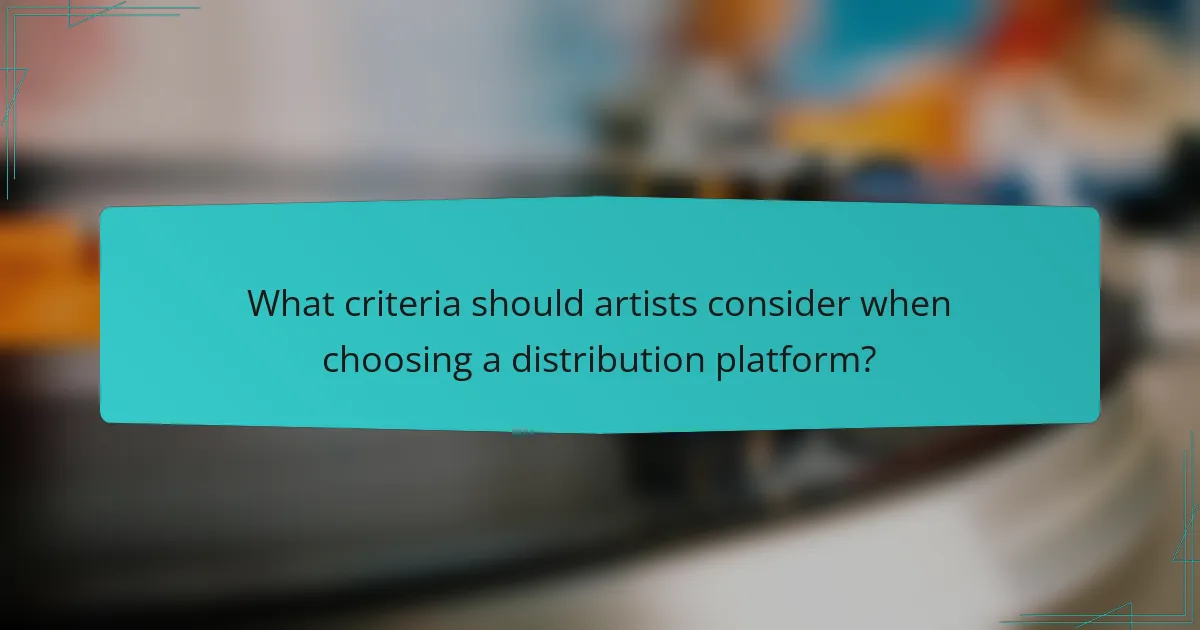
What criteria should artists consider when choosing a distribution platform?
Artists should consider several key criteria when selecting a distribution platform, including fee structures, audience reach, and available features. These factors can significantly impact an artist’s revenue, visibility, and ability to engage with fans effectively.
Fee structures
Understanding the fee structures of distribution platforms is crucial for artists. Most platforms charge a percentage of sales or a flat fee per release, which can vary widely. For example, some may take 15-30% of revenue, while others might charge a monthly subscription fee, making it essential to calculate which option aligns best with an artist’s expected sales volume.
Additionally, be aware of hidden fees, such as those for additional services like promotional tools or analytics. Always read the fine print to avoid unexpected costs that could eat into profits.
Audience reach
Audience reach is a vital consideration, as it determines how many potential listeners will access an artist’s music. Some platforms have partnerships with major streaming services, increasing visibility, while others may focus on niche markets. Artists should evaluate where their target audience is most active and choose a platform that aligns with that demographic.
For instance, platforms like Spotify and Apple Music offer extensive reach, while Bandcamp may cater more to dedicated fans willing to support artists directly. Consider where similar artists in the genre are distributing their music to gauge potential reach.
Features and tools
The features and tools offered by a distribution platform can enhance an artist’s marketing and engagement efforts. Look for platforms that provide robust analytics, promotional tools, and fan engagement features, such as email marketing or social media integration. These tools can help track listener behavior and optimize marketing strategies.
Some platforms also offer unique features like pre-order options, merchandise sales, or crowdfunding capabilities, which can be beneficial for artists looking to maximize revenue streams. Evaluate these offerings to ensure they meet your specific needs and goals as an artist.
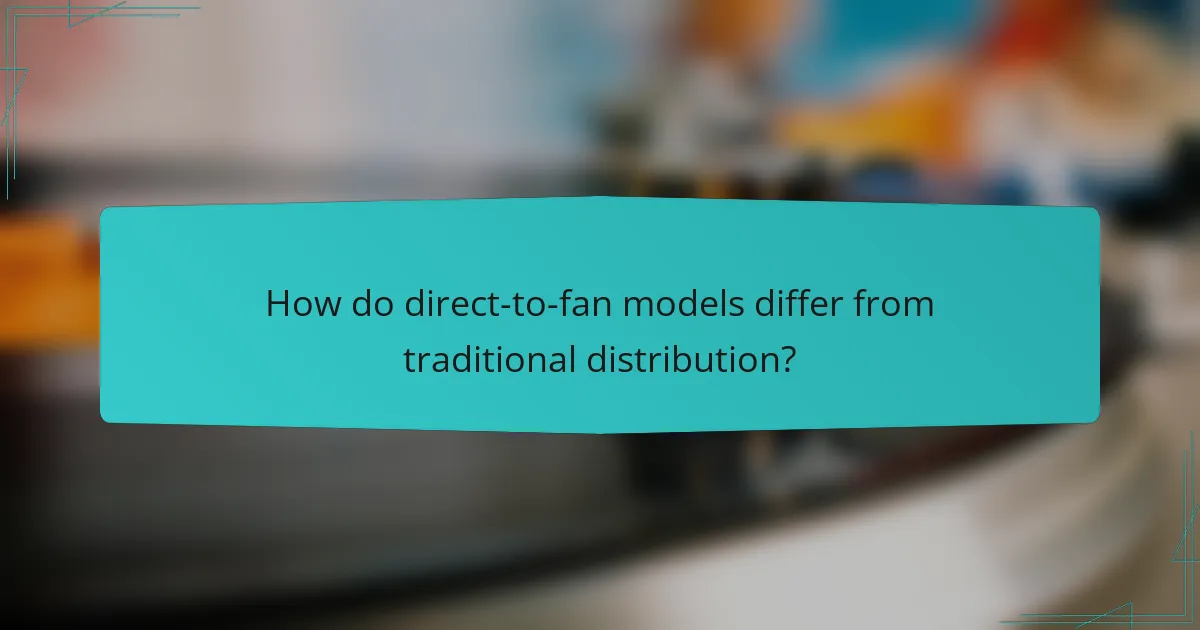
How do direct-to-fan models differ from traditional distribution?
Direct-to-fan models allow artists to sell their music and merchandise directly to their audience, bypassing traditional distribution channels. This approach offers greater control over sales, pricing, and customer relationships, leading to potentially higher profits and more engaged fanbases.
Control over pricing
In direct-to-fan models, artists have the autonomy to set their own prices for music and merchandise. This flexibility enables them to experiment with pricing strategies, such as offering limited-time discounts or bundling products for a better deal.
For instance, an artist might price a digital album at $10 but offer a special promotion at $7 for a limited period. This direct control contrasts with traditional distribution, where record labels often dictate pricing, limiting the artist’s ability to respond to market demand.
Artists should consider their fanbase’s willingness to pay and the perceived value of their work when setting prices. Regularly reviewing pricing strategies based on sales data can help optimize revenue.
